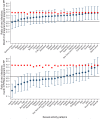HIV acquisition in pregnancy: implications for mother-to-child transmission at the population level in sub-Saharan Africa
- PMID: 34546647
- PMCID: PMC8454677
- DOI: 10.1002/jia2.25783
HIV acquisition in pregnancy: implications for mother-to-child transmission at the population level in sub-Saharan Africa
Abstract
Introduction: A recent sero-discordant couple study showed an elevated risk of HIV-acquisition during the pregnancy/postpartum period per-condomless-coital-act. This, along with previous studies, has led to concern over possible increased risk of mother-to-child (vertical) transmission, due to the initial high viral load in the first months after seroconversion, in a time when the woman and health services may be unaware of her status. This study looks at whether behavioural differences during the pregnant/postpartum period could reduce the impact of elevated risk of HIV acquisition per-condomless-coital-act at the population level.
Methods: We used data from 60 demographic and health surveys from 32 sub-Saharan African countries. Using the HIV status of couples, we estimated differences in serodiscordancy between HIV-negative women who were pregnant/postpartum compared to those who were not pregnant/postpartum. We compare the risk of sexual activity over the pregnant/postpartum period to those not pregnant/postpartum. Using these risks of serodiscordancy and sexual activity along with estimates of increased HIV risk in the pregnancy/postpartum period per-condomless-coital-act, we estimated a population-level risk of HIV acquisition and acute infection, during pregnancy/postpartum compared to those not pregnant/postpartum.
Results: Sexual activity during pregnancy/postpartum varies considerably. In general, sexual activity is high in the first trimester of pregnancy, then declines to levels lower than among women not pregnant/postpartum, and is at its lowest in the first months postpartum. Adjusted for age and survey, pooled results show HIV-negative pregnant women are less likely to have an HIV-positive partner compared to those not pregnant/postpartum (risk ratio (RR) = 0.78, 95% CI = 0.68-0.89) and comparing the postpartum period (RR = 0.85, 95% CI = 0.73-0.99). Estimated population-level risk for HIV acquisition and acute infection in pregnancy/postpartum was lower than would be inferred directly from per-condomless-coital-act estimates in most countries, over the time of most risk of mother-to-child transmission, though there was variation by country and month of pregnancy/postpartum.
Conclusions: Estimates of population-level HIV acquisition risk in sub-Saharan Africa should not be taken directly from per-condomless-coital-act studies to estimate vertical transmission. Changes in sexual behaviour and differences in HIV-serodiscordancy during pregnancy/postpartum reduce the impact of increased risk of HIV acquisition per-condomless-coital-act, this will vary by region.
Keywords: HIV; HIV acquisition; paediatric; postpartum; pregnancy; vertical transmission.
© 2021 The Authors. Journal of the International AIDS Society published by John Wiley & Sons Ltd on behalf of the International AIDS Society.
Conflict of interest statement
The authors declare no conflict of interests.
MM & MIM conceived the analysis, MMar designed the analysis, KR commented on analysis design, MM analysed the data, MM, KR and MIM wrote the article.
Figures







References
-
- Thomson KA, Hughes J, Baeten JM, John‐Stewart G, Celum C, Cohen CR, et al. Increased risk of HIV acquisition among women throughout pregnancy and during the postpartum period: a prospective per‐coital‐act analysis among women with HIV‐infected partners. J Infect Dis. 2018;218(1):16–25. - PMC - PubMed
-
- Gray RH, Li X, Kigozi G, Serwadda D, Brahmbhatt H, Wabwire‐Mangen F, et al. Increased risk of incident HIV during pregnancy in Rakai, Uganda: a prospective study. Lancet. 2005;366(9492):1182–8. - PubMed
-
- Gray RH, Wawer MJ. Probability of heterosexual HIV‐1 transmission per coital act in sub‐Saharan Africa. J Infect Dis. 2012;205(3):351–2. - PubMed
-
- Pilcher CD, Tien HC, EronJJ, Jr., Vernazza PL, Leu SY, Stewart PW, et al. Brief but efficient: acute HIV infection and the sexual transmission of HIV. J Infect Dis. 2004;189(10):1785–92. - PubMed
Publication types
MeSH terms
LinkOut - more resources
Full Text Sources
Medical

